Sound Recording and Editing Software Guide
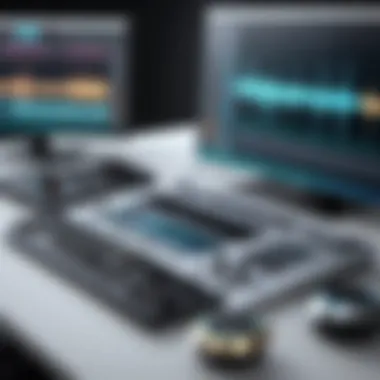
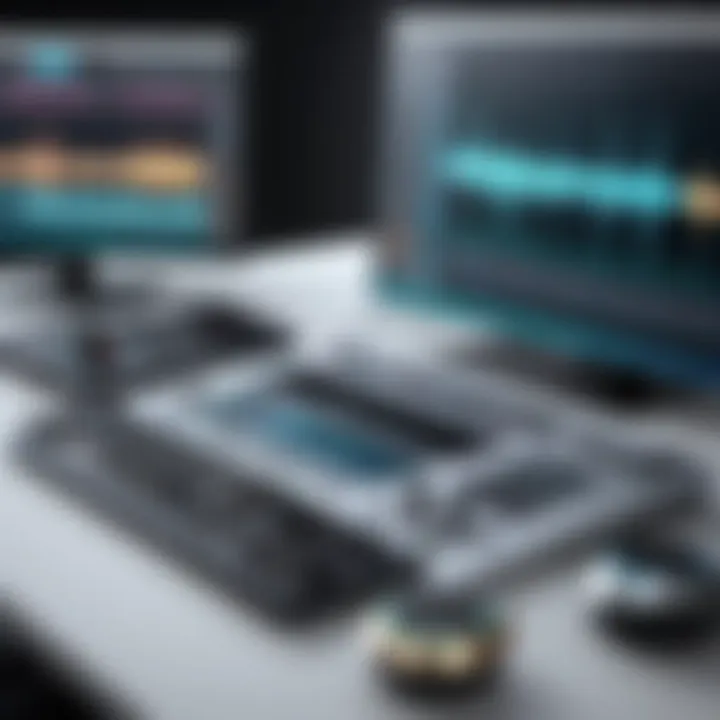
Intro
Sound recording and editing software has become a cornerstone in various industries, serving as the heartbeat of creativity and communication. From musicians crafting their next big hit to filmmakers stitching together a compelling narrative, these tools are essential in shaping the auditory experiences we enjoy in our daily lives. The evolution of this software reflects the growth of technology and its role in the arts, enabling users to push boundaries and experiment with sound like never before.
With the advancement of this software, users can record, edit, and produce a wide range of audio content, from music tracks and podcasts to sound effects for films. This guide endeavors to provide a deep dive into the numerous options available, discussing their functionalities, applications, and user considerations.
Software Overview
Brief Description of Software
Sound recording and editing software encompasses applications designed to capture, manipulate, and produce audio material. At its core, such software allows users to record live sounds or import existing audio files. The manipulation capabilities range from simple editing tasks—like cutting and pasting audio segments—to more complex operations, including mixing multiple tracks or applying real-time effects.
Key Features and Functionalities
The variety of sound recording and editing software in the market can be bewildering for newcomers and experienced users alike. However, several key features stand out:
- Multi-Track Recording: This feature is a game changer, allowing users to record multiple audio sources separately and layer them as needed.
- Editing Tools: Advanced editing functionalities such as cut, copy, paste, and trim can significantly enhance efficiency and precision when working with audio files.
- Audio Effects: Many software packages come equipped with a suite of effects, such as equalization, compression, reverb, and pitch correction, enabling users to fine-tune their sound.
- Automation Features: This allows users to automate changes in volume, panning, and other parameters over time, adding dynamic quality to their recordings.
- User Interface: A clean and intuitive interface complicates the usability aspect, making it easier for even novices to get started without wading through a steep learning curve.
"The right sound editing tool is like a musician's best friend—it knows how to amplify creativity while keeping the grit of real emotion intact."
Understanding these fundamental features facilitates a clearer perspective on how different software options align with individual user needs.
Detailed Comparison
Comparison with Competitors
When considering sound recording and editing software, it’s also beneficial to evaluate how different products stack up against one another. For instance:
- Adobe Audition: Known for its comprehensive audio editing capabilities and seamless integration with other Adobe products, it’s a solid choice for professional audio engineers.
- Ableton Live: Highly regarded in the music production field, especially for electronic music, it offers robust features for both live performance and studio recording.
Understanding the strengths and weaknesses of each software allows potential users to make informed decisions based on their specific requirements.
Pricing Structure
The pricing of sound recording and editing software can vary significantly, depending on features, target users, and licensing models. Here’s a brief overview:
- Subscription-Based Model: Services like Adobe Audition follow a monthly or annual subscription, providing regular updates and newer features.
- One-Time Purchase: Software like FL Studio usually allows for a one-time payment, granting lifetime access to the version purchased.
Ultimately, understanding what you need and matching that with a product's pricing structure can lead to a more satisfying experience when navigating the world of sound recording and editing.
Foreword to Sound Recording and Editing Software
In today's fast-paced digital landscape, sound recording and editing software is more than just a tool; it's an integral part of creating and sharing audio content. Whether it's for music production, podcasting, or even sound design for films, understanding the intricacies of these software programs is crucial for professionals working across various industries. The way audio is captured, manipulated, and edited can significantly impact the quality of the final product.
One of the first things to recognize about sound recording software is its role in democratizing audio production. In the past, high-quality recording equipment was often restricted to established studios with hefty budgets. However, advancements in technology have shifted the landscape, making it accessible for independent musicians and content creators. The availability of user-friendly interfaces and powerful features enables anyone with a computer to produce professional-grade audio. This accessibility isn't just a trend; it's a revolution that has changed how we engage with audio content.
Key elements to consider when exploring sound recording and editing software include its functionality, user-friendliness, and the quality of its output. Many applications come packed with features, such as multitrack recording, advanced editing tools, and a variety of plugins for sound effects. These capabilities allow creators to enhance their projects significantly while affording them creative control. However, the abundance of options might also leave some users feeling overwhelmed, making it necessary to understand the basics before diving into more complex areas.
Benefits extend beyond mere convenience; effective use of sound software can enhance storytelling in various media, be it music, podcasts, or video. The selection of the appropriate software can mean the difference between a polished creation and a rough draft. Pay attention to how different solutions cater to varying expertise levels, as software designed for beginners might not host the advanced features required by seasoned professionals.
With the right tools at their fingertips, users can transform not just how they produce audio but also how audiences experience it. Therefore, this guide aims to navigate these waters, shedding light on the importance of sound recording and editing software while providing insights that help users make informed choices in selecting the right applications for their needs. The landscape is continually evolving, and staying informed is key to harnessing the power of sound in storytelling and content creation.
Historical Context of Sound Recording Software
Understanding the historical backdrop of sound recording software is akin to getting a map of a vast landscape before you venture into the wild. It not only provides clarity on how we arrived at our current technological offerings but also highlights the advantages and hurdles faced along the way. This context is vital for decision-makers and IT professionals seeking to utilize or develop sound recording systems.
Evolution of Sound Recording
The journey of sound recording is a fascinating saga that began in the late 19th century. It all kicked off with the phonograph, invented by Thomas Edison in 1877. This machine might seem rudimentary by today's standards, yet it was a groundbreaker. It introduced the idea of capturing audio, which has progressively evolved into complex digital solutions we see now.
From the initial mechanical devices like the gramophone, which used wax cylinders, to magnetic tape, the evolution of sound recording has been propelled by both artistic and technological forces. The transition to analog formats in the mid-20th century, particularly with the advent of reel-to-reel tape recorders, marked a significant milestone. These devices allowed for multi-track recording, giving artists finer control over their compositions.
Fast forward to the late ‘70s and early ‘80s, the digital revolution began to reshape the audio landscape. The introduction of the Compact Disc in 1982 allowed for a clearer and more durable medium for music storage. The arrival of Digital Audio Workstations (DAWs) in the 1990s transformed recording processes, enabling users to record multiple audio tracks simultaneously, edit them with precision, and apply various effects seamlessly.
Technological Advancements in Sound Editing
With sound recording evolving, editing technology had to rise to the occasion. The development of sound editing software brought along a plethora of tools that empowered sound engineers and producers. Tools for manipulating sound waves, adjusting tempo, and mixing tracks are now commonplace. For example, software such as Pro Tools has become a benchmark in the industry for professional audio editing.
Moreover, today’s sound editing solutions sport features that were considered futuristic just a decade ago. Real-time collaboration tools allow multiple users to work on a project from different corners of the globe, a stark contrast from the days of requiring all collaborators to be in the same studio. In addition, the integration of artificial intelligence in sound editing has streamlined tedious processes, making it easier for even novice users to engage in sophisticated audio work.
"The history of sound recording is a testament to human creativity, showcasing how technological evolution not only changes production but redefines art itself."
This blend of historical context and technological growth offers deep insight into how sound recording and editing software developed. Understanding these changes equips professionals with better tools and knowledge to contribute meaningfully to the field. The timeline isn’t just academic; it informs noteworthy decisions in purchasing, implementing, and utilizing today’s sound recording and editing software.
Key Types of Sound Recording Software
Understanding the various types of sound recording software is crucial for anyone involved in audio production, whether you’re just starting out or you’re an experienced professional. Each category of software has distinct features that cater to different needs and workflows. By breaking it down into key types, users can identify which tools are best suited for their projects, enhancing both productivity and creative potential.
Digital Audio Workstations (DAWs)
Digital Audio Workstations, or DAWs, are the backbone of modern sound recording and production. These powerful platforms allow users to record, edit, mix, and produce audio with unprecedented precision. A DAW acts as a virtual studio; it's where musicians lay down tracks and engineers fine-tune recordings.
Popular DAWs like Ableton Live, Pro Tools, and Logic Pro X offer a myriad of tools for audio manipulation. The interface typically includes a timeline for arranging sound clips, various virtual instruments, and effects that can be applied to enhance audio quality.
The strength of a DAW lies not only in its ability to handle multiple audio tracks but also in the level of detail it provides. Features such as midi sequencing, automation of effects, and extensive plugin support make DAWs indispensable. New users might feel overwhelmed due to the complex functionality, but resources like online tutorials and community forums can ease the transition.
Audio Editors
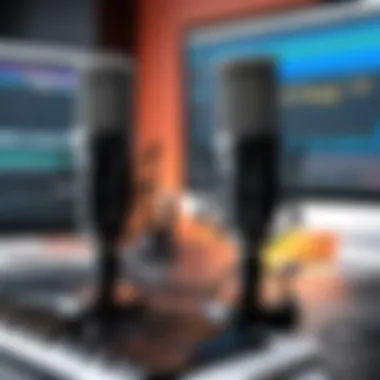
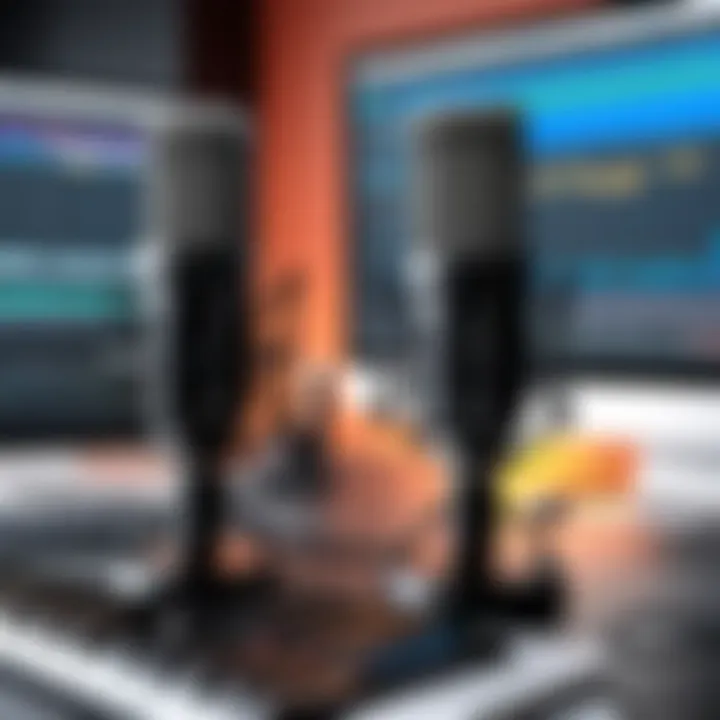
While DAWs offer a comprehensive set of features for music production, audio editors serve a more specific purpose—editing existing audio files. They excel in refining recorded material, whether it�’s trimming unwanted silence, applying effects, or correcting pitch. Software like Audacity or Adobe Audition exemplifies audio editing tools that focus on detail.
Audio editors are especially useful for tasks that require precision, such as removing noise or breath sounds from recordings. The intuitive interface of these tools often allows users to conduct edits directly on the waveform, making it easy to see where changes need to occur. This level of control can be vital for post-production tasks in film and video editing, ensuring that sound aligns perfectly with visuals.
Multitrack Recorders
Multitrack recorders blur the lines between DAWs and traditional recording solutions. They allow users to capture multiple audio tracks simultaneously but usually are more straightforward than full-fledged DAWs.
Devices like the Tascam DP-32SD or software options like GarageBand enable musicians and podcasters to record each component of their project in isolation, which can lead to a cleaner mix later on. For instance, a band might record each instrument separately, which allows for easier adjustments in volume or effects, enhancing the overall quality of the production.
In an age where live recording sessions often require quick setups and easy operation, multitrack recorders are becoming more popular. Their user-friendly nature appeals to those who may not need the extensive capabilities of a DAW or feel overwhelmed by its complexity.
In summary, the type of sound recording software that best suits an individual or team's needs depends heavily on their specific goals and expertise.
Each category serves its purpose, be it for detailed audio manipulation with an audio editor, comprehensive production with a DAW, or straightforward recording with a multitrack recorder. When selecting software, one must weigh the benefits and limitations of each type against the demands of their project.
Crucial Features in Sound Editing Software
When embarking on the journey of sound recording and editing, one quickly realizes that not all software is created equal. Various features play a pivotal role in not just determining ease of use, but also in elevating the quality of audio projects. Indeed, crucial features in sound editing software influence everything from user experience to the final output. Below, we explore key aspects that can make or break the sound editing process.
User Interface Design
User interface (UI) design may seem like a buzzword, but its significance in sound editing software can't be overlooked. A well-crafted UI allows users to navigate through complicated tasks with relative ease. Imagine you're deep into a project, and the interface is a maze of buttons and options — it can be maddening. Effective UI reduces friction, helping users locate tools without unnecessary hassle.
Good UI design often includes intuitive layouts, clear labeling, and responsive controls. Color coding elements can also provide a visual relief, particularly when one has to manage multiple tracks. Moreover, customizable interfaces allow users to arrange tools according to their working style. Whether you prefer all your effects accessible at a glance or a more streamlined view, a flexible UI can adapt to your needs.
"A well-designed interface is like a well-written essay; it guides the reader smoothly from beginning to end without distractions."
Audio Effects and Plugins
While the raw audio quality is essential, it’s often the effects and plugins that take a sound recording from ordinary to extraordinary. In the world of sound editing software, audio effects can range from reverb to equalization, each serving a unique purpose. The availability and variety of these effects can significantly shape the sonic character of a project.
Plugins, on the other hand, enhance the software’s capabilities. They can be used for specialized tasks, from mastering tracks to creating intricate soundscapes. Software with a rich library of effects and the ability to support third-party plugins offers flexibility that professionals often seek.
- Important effects to consider:
- Reverb: Creates the illusion of space.
- Compression: Balances audio levels and adds punch.
- Equilization (EQ): Fine-tunes frequency ranges to enhance clarity.
The right plugins can also automate tasks that would otherwise be tedious, thus giving sound engineers more time to experiment creatively.
Export Options
At the end of a production, the final output needs to be handled with care. Export options are crucial as they determine the format and quality of the final product. Most sound editing software today supports a variety of formats, from MP3 to WAV, catering to different needs.
When choosing software, consider the following export features:
- Format Variety: More options mean better adaptability.
- Quality Settings: Higher quality settings may come with larger file sizes; balance is key.
- Batch Export: Enables exporting multiple files simultaneously, saving valuable time.
Additionally, many sound editing platforms today offer cloud integration for sharing files effortlessly. This facilitates collaboration, particularly valuable in team settings where feedback loops are rapid.
Considerations for Selecting Software
Choosing the right sound recording and editing software isn't just a matter of finding the most popular option on the market. A number of factors must align with the specific needs of the user and the goals of their projects. Especially as technology evolves, decision-makers must carefully weigh several considerations to ensure they select the most effective tools available.
Budget Constraints
When it comes to sound software, 'you get what you pay for' often rings true. However, it’s not strictly about spending the most money; rather, it’s about how well the software fits the intended use. Many users may find that there are excellent, cost-effective options that provide significant value without breaking the bank.
- Set a clear budget: Knowing how much one can allocate for sound software is crucial. Think about both initial costs and possible subscription fees that might accumulate over time.
- Consider pricing tiers: A variety of software options range from free versions to premium packages. Investigate which features are essential for your needs and see what fits within your budget.
- Evaluate return on investment: To truly understand the worth of any software, put it in context. A less expensive program may suffice for a hobbyist, while a more costly solution might be warranted for a professional setting requiring advanced capabilities.
Compatibility with Hardware
Technological harmony is key when selecting software. A program that runs like a dream on one system might crash and burn on another. Pay close attention to hardware requirements to avoid compatibility issues that could derail productivity.
- Specifications check: Always refer to the minimum and recommended system requirements. Software specifications can differ significantly based on whether one is using an older system, a newer machine, or a combination thereof.
- Audio interfaces: If using external audio equipment, ensure there’s compatibility. Problems may arise if your chosen software doesn't support the type of audio interface you own.
- Operating systems: Confirm compatibility with your operating system. Some high-end sound editing tools may only run on Windows or Mac, which could limit options if using Linux or another OS.
Level of Expertise Required
The user’s familiarity with sound editing software should guide selection. Whether you are new to the world of sound recording or are a seasoned pro can make a vast difference in where to start.
- Beginner-friendly options: Users who are just entering the field should consider software that offers intuitive layouts, such as GarageBand or Audacity. These programs may lack some advanced features but offer a smooth learning curve for newcomers.
- Professional tools: On the other hand, experienced users may benefit from software like Pro Tools or Ableton Live that provide an extensive range of advanced features tailored for professionals. However, they come with steeper learning curves.
- Training resources available: It’s worthwhile to investigate whether the software has a strong community or support network. Many times, software with robust tutorials and forums can help users overcome challenges more efficiently.
Choosing the right software means aligning project needs with capabilities, considering both immediate constraints and long-term goals.
Taking the time to assess budget, hardware compatibility, and user expertise helps narrow down choices in the crowded landscape of sound recording and editing tools. Making informed decisions can significantly enhance the overall workflow and creative output, proving beneficial in the long run.
Impact of Technology on Music Production
The world of music production has seen a seismic shift with the advent of advanced technology. This evolution is not just about creating more polished sounds; it fundamentally reshapes the way artists compose, produce, and distribute their work. These changes have implications for everyone in the music industry—from the musicians themselves to producers, listeners, and even marketers.
Changes in Composition Techniques
Gone are the days when musicians relied heavily on traditional instruments and studio time. With the rise of software-based production tools, composing music has become a more accessible and versatile process. For instance, have a look at how programs like Ableton Live and FL Studio have changed the game. Musicians can now layer sounds, experiment with beats, and apply various effects all in real time. Oftentimes, an artist can create entire tracks using nothing but their laptop and a pair of headphones.
These tools empower creativity. If an artist has a spark of inspiration at midnight, they no longer need to wait for studio hours. Instead, they can jump right into their DAW, laying down ideas and refining them instantly. The use of MIDI instruments and virtual synthesizers enables musicians to explore soundscapes that were previously hard to achieve without spending a fortune on equipment.
"Technology has democratized music creation. It puts power in the hands of the creator rather than the industry gatekeepers."
— Anonymous
Moreover, collaboration opportunities have skyrocketed. Artists from different corners of the globe can work together in real time, thanks to cloud-based platforms. This synergy has birthed new genres and collaborations, further solidifying the importance of technology as a driving force in music production.
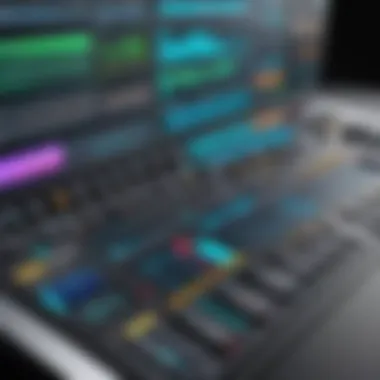
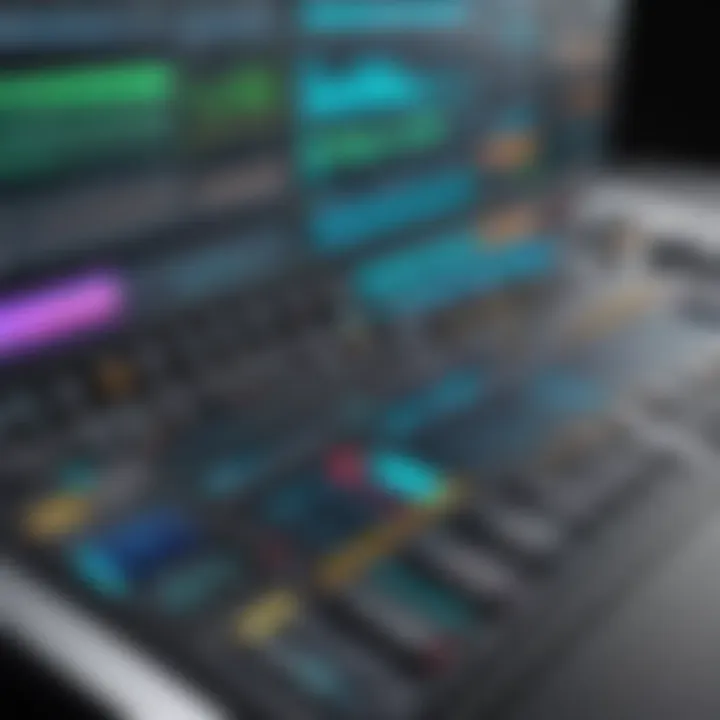
Distribution of Music in Digital Age
Once a track is produced, the next question is—how does it reach the audience? The digital age has revolutionized music distribution pathways. Platforms like Spotify, Apple Music, and Bandcamp have made it easier for independent artists to share their work without needing a major record label. This shift significantly lowers barriers to entry for upcoming musicians.
In the past, distributing music often meant dealing with physical records, pressing, and shipping—a cumbersome process that could take weeks or even months. Today, an artist can upload their song within minutes and make it available to millions around the world. This immediacy allows for a more dynamic interaction with audiences, letting musicians respond to feedback in real-time and adjust their marketing strategies accordingly.
Further, social media platforms like Facebook and Reddit have become critical marketing tools for artists. Musicians can directly engage with fans, share snippets of new music, and promote live shows, all of which cultivates a loyal fanbase. The ability to create viral moments has given many indie artists the push they need to break through to wider recognition.
In summary, the impact of technology on music production cannot be overstated. It has transformed not only the creation process but also how music is distributed and consumed, paving the way for limitless possibilities in the music industry.
Role in Film and Video Editing
The role of sound recording and editing software in film and video editing cannot be overstated. It serves as the backbone of the audio-visual experience, helping to create a seamless and compelling story. The integration of high-quality sound elevates a film from a mere collection of visuals to a fully immersive experience. Various elements, such as dialogue clarity, sound effects accuracy, and musical score synchronization, play essential roles in achieving this goal. In today’s competitive film industry, a well-crafted audio track is as crucial as captivating visuals. It can enhance emotions and draw the audience into the narrative in a way that visuals alone often cannot.
Here, we will explore two significant components of sound editing in film: syncing audio with visuals and post-production workflows.
Syncing Audio with Visuals
Syncing audio with visuals is like piecing together a puzzle where each sound aligns with an action on screen. This process involves meticulous attention to detail, as even the smallest misalignment can disrupt viewer immersion. For example, the dramatic effect of a door creaking open can fall flat if the sound doesn't match the image of the door moving.
Several techniques enhance this synchronization:
- Waveform Matching: Observing sound waveforms alongside video tracks helps in aligning sounds accurately.
- Clapperboards: Traditionally used during filming, these tools make it easier to synchronize audio and visuals in post-production.
- Timecode Systems: These ensure that audio recordings are perfectly timed with visual cues, providing a reliable reference throughout the editing process.
The need for precise syncing is particularly pronounced in action sequences or comedic scenes, where timing can dictate the impact of the scene. With sound software such as Avid Pro Tools or Adobe Audition, editors can adjust audio levels, apply filters, and meticulously synchronize sound effects to enhance the overall experience.
Post-Production Workflows
Post-production workflows outline the steps followed after filming to refine sound, create effects, and craft the final piece. A structured workflow is critical for efficiency and quality. It often begins with sound design, where sound editors collaborate with filmmakers to devise an auditory landscape that complements the visual narrative. This typically includes:
- Dialogue Editing: Cleaning up recorded dialogue, removing extraneous noise, and ensuring clarity.
- Sound Effects Creation: Crafting unique sounds that align with actions, often requiring creativity and innovative software tools.
- Mixing: Balancing all audio elements—dialogue, sound effects, and music scores—ensuring they blend harmoniously together.
Then comes the mastering phase, where the final mix undergoes tweaking to reach optimal volume and quality for various formats and platforms. This part of the process is essential, especially with the varying sound systems of home theaters and cinemas.
"In film editing, sound is not merely an addition; it is an essential force that shapes how the audience perceives the narrative and emotional texture."
With the right sound recording and editing software, editors can navigate these workflows seamlessly, creating a polished product that resonates with audiences. The choices made in this stage affect not only the film's quality but also its reception and profitability. By leveraging powerful tools and implementing effective workflows, sound editors play a vital role in determining a film’s ultimate success.
Applications in Podcast Production
Podcasting has exploded in recent years, becoming a significant medium for content consumption and communication. The importance of sound recording and editing software in this realm cannot be overstated. In a landscape where listeners are inundated with choices, producing clear and engaging audio is paramount.
Podcasts rely heavily on quality audio to retain audience attention and deliver a powerful message. Poor sound quality can lead to listener fatigue or, worse, cause them to switch off entirely. Therefore, using the right software tools is crucial for podcasters aiming to create a professional and enjoyable listening experience. Proper editing techniques and software with user-friendly interfaces are key elements that any ambitious podcaster must consider.
Editing Techniques for Clarity
When it comes to podcast editing, clarity is king. The goal is to ensure that the spoken word is as crisp as a spring morning. Techniques like noise reduction, equalization, and compression play vital roles in achieving this clarity.
- Noise Reduction: Environment noise, such as background chatter or fan sounds, can detract from the listener’s experience. Software like Audacity or Adobe Audition offers noise reduction features to help remove unwanted sounds. This is particularly important when recording in less-than-ideal environments.
- Equalization: Adjusting frequency levels can make voices sound more natural. By cutting out unnecessary low frequencies and enhancing the mid-range where human voices generally sit, the overall clarity can be noticeably improved.
- Compression: This technique helps balance volume levels, bringing softer sounds up and reducing louder ones. It avoids audio peaks that could cause distortion and ensures a smooth listening experience.
Implementing these techniques not only improves audio quality but also demonstrates professionalism, enhancing credibility among audiences.
Tools for Enhancing Listener Experience
As vital as the editing techniques are, the tools employed can make a world of difference in how a podcast is perceived by its audience. Here are several software options that can elevate the listener experience:
- Descript: Integrated tools like transcription make it easier to edit audio by editing text. This enables users to craft narratives meticulously while simplifying the editing process.
- Alitu: This platform is designed specifically for podcasting, offering a straightforward interface where users can record, edit, and publish all in one place. It even provides features for adding music and jingles effortlessly.
- Hindenburg Journalist: Famous for its focus on audio storytelling, this software features automatic leveling, which is particularly useful for interviews or discussions where speakers have varying vocal intensities.
These tools not only streamline the production process but also add layers of functionality that can enhance the overall listener engagement. By leveraging intuitive software, podcasters can focus more on content while ensuring their audio quality appeals to their target audience
"In podcasting, the sound quality often speaks volumes about professionalism. Investing in the right software can make the difference between a fleeting interest and a loyal audience."
The warm embrace of professional sound recording and editing software enables podcasters to realize their creative visions while ensuring that the listener's experience is as seamless as possible. As this medium continues to grow, staying informed about the best tools and practices is essential for any aspiring podcaster.
Emerging Trends in Sound Editing Software
The landscape of sound editing software is not static; it evolves with the times, driven by new technologies and changing user needs. Understanding these emerging trends is crucial for professionals looking to stay ahead in the game. As industries increasingly rely on audio for storytelling and brand engagement, the software that enables the creation and manipulation of sound becomes ever more sophisticated and accessible. The integration of cutting-edge technologies and the rise of online solutions are paving the way for a more innovative future in sound editing.
Artificial Intelligence Integration
Artificial Intelligence is reshaping how audio is created, edited, and produced. Tools that harness AI capabilities can automate labor-intensive tasks, allowing professionals to focus on the creative elements of their work. With machine learning algorithms analyzing audio data, software can now offer intelligent suggestions for audio adjustments, corrections, and even content generation.
For example, SmartEQ, an intelligent equalizer, listens to an audio track, assesses its tonal balance, and recommends adjustments. This not only saves time but often leads to a more polished final product. Here are some key benefits of AI integration in sound editing:
- Efficiency: Automating repetitive tasks allows sound engineers to produce work faster and with greater accuracy.
- Enhanced Creativity: With mundane tasks handled by software, professionals can channel their energy into experimenting with new ideas and sounds.
- Accessibility: Advanced AI capabilities make high-quality recording and editing tools accessible to those with less experience, democratizing audio production.
However, considerations remain about the reliance on AI. While it can enhance workflows, understanding the technology behind it is essential to ensure that artistic vision isn't compromised by over-reliance on automated features.
Cloud-Based Solutions
One of the most significant shifts in sound editing software is the move toward cloud-based solutions. This trend is geared toward flexibility and collaboration, offering users the ability to access software from any device connected to the internet, without heavy installations.
Platforms like Soundtrap and Avid Cloud Collaboration enable multiple users to work on a project in real time, serving as a powerful tool for teams spread across different locations. The advantages of cloud-based solutions include:
- Cost-Effectiveness: Many cloud-based options come with subscription models, reducing upfront costs and allowing users to pay only for what they need.
- Collaboration: Real-time editing and project sharing foster collaborative efforts among professionals, educators, and budding artists alike.
- Scalability: Users can easily expand their resources as needed, allowing flexibility in projects ranging from casual home recordings to extensive commercial productions.
Nonetheless, considerations like internet connectivity and data security remain pertinent. Users must ensure reliable connections and understand vendor security practices when entrusting their work to cloud environments.
The blend of AI and cloud solutions represents a significant turning point in sound editing, with the potential to revolutionize not just how audio is produced but who has the tools to create it.
In summary, staying attuned to these emerging trends—AI integration and cloud-based solutions—will be vital for anyone involved in sound editing, from independent artists to tech-savvy producers. Embracing these innovations may define the next era of audio production.


Challenges in Sound Software Implementation
The adoption and effective use of sound recording and editing software can present a multitude of challenges for users. Understanding these obstacles is crucial for professionals in the field, as it allows them to make informed decisions regarding software selection and utilization. This section sheds light on common hurdles in implementation, focusing on user experience and software reliability.
Learning Curve for Users
One of the primary challenges users face is the steep learning curve associated with many of the advanced sound editing tools available today. A software's complexity can significantly hinder its initial adoption, especially for those who might not have a musical background or technical expertise. The intricacies of features and interfaces can feel like walking through a maze without a map, leading to frustration.
Furthermore, different software has its unique workflow, which means that a user proficient in one program might find themselves lost when transitioning to another. To ameliorate this issue, many companies now provide tutorials and community forums. Engaging with platforms like reddit.com for user experiences can help clarify features and provide practical tips.
"The best tools are only as effective as the users behind them; familiarity breeds competence."
Investing time to learn these tools is essential, as a lack of understanding tends to limit the creative potential of sound editing. For organizations, providing comprehensive training programs can bridge these knowledge gaps, ensuring that users feel equipped to leverage the software’s capabilities.
Software Stability and Support
Another noteworthy challenge is software stability and the availability of support. Users often rely on their software during critical phases of production—be it for a music release or a tight video deadline. A crash or a glitch not only causes delays but can also lead to the loss of precious audio files.
Quality control varies widely among sound editing tools. Some products are well-known for their robust architectures, while others may have persistent bugs and issues. Hence, when deciding on a software package, it is vital to consider user reviews and feedback on updates.
Support from the developer is equally important. Does the company offer timely updates? Is customer service readily available for troubleshooting? These factors can greatly influence user experience. Professionals should ensure that they choose well-supported software to avoid headaches down the line.
In summary, grappling with the learning curve and ensuring stability and support are crucial considerations that affect how effectively sound editing software can be implemented. Addressing these challenges head-on can foster a more productive and creative environment for users across various industries.
Case Studies of Successful Implementations
The examination of case studies within the realm of sound recording and editing software is vital in understanding how these technologies transform creative processes. These case studies serve as practical examples that illustrate the challenges, innovative solutions, and outcomes achieved by various users across industries. They highlight not only the effectiveness of specific software but also the significant advantages that can arise from adopting the right tools.
In today’s competitive landscape, it’s more essential than ever for professionals, especially independent artists and podcast networks, to leverage technology effectively. For many, the right software not only enhances their creative capabilities but also streamlines workflows and increases market reach. Here, we dive into two distinct yet equally transformative case studies: the rise of independent artists through technology and the strategic utilization of sound software by podcast networks.
Independent Artists Leveraging Technology
Independent artists often find themselves at a crossroads between limited resources and a desire for high-quality production. In fact, recording and editing software provides them with the flexibility to create professional-grade music without the constraints of traditional studios. This democratization of technology allows talent to shine regardless of their geographical or financial limitations.
For instance, an artist might use software like Ableton Live to produce tracks at home, taking advantage of built-in functions like sample manipulation and MIDI sequencing. The artist can play around with various audio effects, enhancing their sound without needing an expensive microphone or soundboard. Moreover, platforms such as Bandcamp enable them to distribute their work directly to listeners, effectively eliminating the middleman.
Key benefits experienced by these artists include:
- Cost Efficiency: Reduced expenses related to studio time.
- Creative Freedom: The ability to explore various genres and sounds at their own pace.
- Immediate Feedback: Quick iterations based on audience reactions via social media platforms.
Interestingly, one independent band reported that their decision to utilize software like Logic Pro X not only helped them in crafting their debut album but also built a loyal fanbase through targeted online marketing efforts. They leveraged comprehensive audio editing tools that made their tracks radio-ready. This illustrates how technology enabled them to sustain their art while promoting it effectively in a crowded marketplace.
Podcast Networks Utilization
Similarly, podcast networks are increasingly relying on sound recording and editing software to shape their offerings. The explosive growth of podcasts has generated an ecosystem where high-quality audio is paramount. Networks such as Radiotopia or Earwolf understand that clear sound and engaging content are the backbone of successful productions.
Utilizing software like Audacity or Adobe Audition enables these networks to enhance the listener experience significantly. They can edit episodes seamlessly, add sound effects, and eliminate unnecessary background noise to maintain listener engagement.
Some critical aspects these networks focus on when employing sound software include:
- Quality Control: Ensuring that every episode meets a professional standard.
- Brand Identity: Utilizing unique audio markers to establish a recognizable sound brand.
- Analytics Integration: Using tools that allow tracking listener engagement metrics for future improvement.
For instance, The Daily, produced by The New York Times, employs sophisticated editing techniques. Their team combines sound bites, narrative storytelling, and ambient soundscapes to deliver a compelling audio experience. Through effective sound editing, they have positioned themselves as a frontrunner in the podcasting world, achieving millions of downloads.
By analyzing these case studies from independent artists and podcast networks, it becomes apparent that sound recording and editing software not only make the process more accessible but also enrich content quality. As technology continues to evolve, it will be interesting to see how these sectors adapt and innovate further.
Future Directions in Sound Software Development
As the digital landscape continues to evolve, the realm of sound recording and editing software is experiencing a significant transformation. Understanding the future directions in sound software development is crucial for industry professionals, as it not only influences current practices but also shapes the strategies that decision-makers and entrepreneurs need to adopt. The rapid advancements in technology, shifting user expectations, and emerging trends all play pivotal roles in shaping the future of sound editing tools.
Potential Innovations on the Horizon
The horizon for sound recording software is lit with numerous innovative possibilities. One notable trend is the continued integration of artificial intelligence into digital audio workstations. This integration opens doors for smarter tools that can automate tedious tasks like mastering and noise reduction. For instance, software could analyze a track and suggest optimal adjustments, making the editing process less cumbersome.
- AI-Driven Features: Emerging AI tools can learn from user preferences, enhancing user experience by making personalized suggestions.
- Smart Mixing Consoles: Future innovations may yield mixing consoles that can automatically balance audio levels and apply effects intelligently based on genre or content, significantly cutting down production time.
Another area ripe for development is the implementation of virtual and augmented reality elements in sound editing. Imagine a scenario where sound designers can manipulate audio in a 3D space, dragging sound waves with motion controls to create immersive experiences. This kind of functionality could revolutionize how audio is created and perceived in industries like gaming and film.
"The future of sound editing isn't just about editing; it's about creating experiences that resonate on a deeper level with audiences."
Market Trends and Predictions
As we look ahead, several market trends signal how sound recording software will progress. One key prediction centers around the growth of cloud-based solutions. Increasingly, producers are shifting towards collaborative models that allow multiple users to work on projects in real time, regardless of their geographical locations. By leveraging cloud computing, sound editing tools will become more accessible, facilitating easier collaboration across teams.
Additionally, the demand for mobile solutions is expected to rise. With the proliferation of smartphones and tablets, users are seeking more powerful applications that can provide robust recording and editing features on-the-go. This shift will drive software developers to focus on optimizing performance, ensuring these tools can deliver high-quality audio production capabilities from handheld devices.
Key considerations for businesses looking to invest in sound software will include:
- User Accessibility: Ensuring the software is intuitive enough for beginners while maintaining depth for professionals.
- Integration with Existing Tools: Compatibility with other industry-standard software will be vital for seamless workflows.
- Subscriptions vs. One-Time Purchases: Understanding user preferences regarding payment models will dictate how companies price their offerings in the competitive landscape.
As the industry continues to evolve, staying abreast of these trends and innovations will be key for sound professionals aiming to maintain a competitive edge.
Ending and Final Thoughts
Navigating the intricate landscape of sound recording and editing software reveals its pivotal role in modern creative endeavors. This article has explored a plethora of aspects, from the rich history and evolution of sound technology to the emerging trends keeping pace with advancements in machine learning and cloud computing. Each section has shed light on the functionality and capabilities of various types of software—be it a Digital Audio Workstation like Ableton Live or specialized audio editors such as Audacity.
The importance of selecting appropriate sound editing software cannot be overstated. For professionals in music production, podcast creation, or film editing, the right tools can significantly enhance efficiency and creativity. It’s notable how features such as user-friendly interfaces, extensive plugin options, and export capabilities can dictate the user experience. Moreover, understanding the infrastructure and compatibility of these tools with the hardware at hand ensures a smooth workflow.
"The tools we use shape our work; choosing wisely is essential to mastering the craft."
Investing time to grasp the intricacies of each software platform allows users to make informed decisions. Given the rapid technological changes, being aware of market trends is advantageous; it avoids the pitfalls of hardware-software misalignment and outdated techniques that can hinder progress.
Finally, as we look forward, the marriage of audio editing software with emerging technologies will shape the future of sound. Whether it’s the integration of AI tools for sound mixing or the promise of remote collaboration via cloud solutions, the horizons are expanding.
In summation, this comprehensive guide serves not merely as a resource but as a starting point for further exploration. Embracing the right sound recording and editing software ultimately leads to fulfilling the potential of creativity in all its forms, ensuring that whether in music, podcasts, or film, creators have the tools they need to resonate with audiences.







